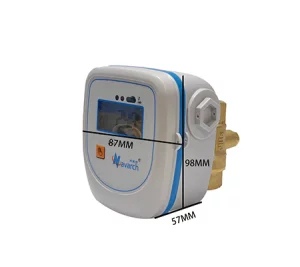لتجنب تأخير الرد على استفسارك، يرجى إدخال رقم WhatsApp/WeChat/Skype الخاص بك مع الرسالة، حتى نتمكن من الاتصال بك في المرة الأولى
سنرد عليك خلال ٢٤ ساعة. في حال وجود أي طارئ، يُرجى التواصل عبر واتساب: +٨٦ ١٣١٨٨٨٩٩٠٣٦، أو وي تشات: ٠٥٣١-٨٧٩٦٨٧٧٧، أو الاتصال مباشرةً على ٠٥٣١-٨٧٩٦٨٧٧٧.
* نحن نحترم خصوصيتك، وجميع معلوماتك محمية. سنستخدم معلوماتك فقط للرد على استفساراتك، ولن نرسل لك رسائل بريد إلكتروني أو رسائل ترويجية غير مرغوب فيها.
Outdated valves waste energy, cause inaccurate flow control, and increase downtime in industrial systems. These inefficiencies escalate costs and complicate maintenance. The solution is an intelligent valve—a smart, sensor-driven device that offers real-time data, adaptive control, and seamless integration with automation systems for superior performance.
An intelligent valve is a sensor-equipped control valve with a built-in controller و positioner that adjusts flow based on real-time system data. Unlike conventional valves, it self-optimizes for maximum energy efficiency, enabling remote monitoring, diagnostics, and automation. It integrates with communication protocols like Modbus, BACnet, and Bluetooth for precise, reliable, and efficient flow control in HVAC, refrigeration, and industrial applications.

intelligent valve controller in industrial systems
أن intelligent valve combines a control valve, مشغل, and integrated controller with advanced sensing capabilities. It adjusts in real time to system conditions like ضغط, درجة حرارة، و معدل التدفق. Unlike traditional mechanical valves, intelligent valves use embedded sensors و positioners to ensure precision and responsiveness.
For example, a pressure independent control valve (PICV) maintains stable flow regardless of pressure fluctuations. With a built-in microcontroller, it processes sensor input and communicates system status through digital protocols. This integration helps minimize energy consumption while maintaining high operational reliability.
Traditional actuators perform binary functions—open or close a valve—based on external commands. In contrast, an intelligent valve controller interprets system data, modulates valve position, and even diagnoses internal anomaly indicators.
| ميزة | Standard Actuator | Intelligent Valve Controller |
|---|---|---|
| Valve Modulation | محدود | Fully adaptive |
| Diagnostic Feedback | لا | نعم |
| Sensor Integration | لا | Yes (temp, flow, pressure) |
| المراقبة عن بعد | يدوي | Built-in support |
| كفاءة الطاقة | معتدل | Optimized via analytics |
This ability to communicate, learn, and adapt to system demand makes intelligent controllers essential in high-performance systems.
They also excel in energy management systems where real-time measurement, optimization, and system intelligence are critical.
For HVAC engineers and automation professionals, intelligent valves bring transformational benefits:
An intelligent HVAC setup can reduce energy consumption by up to 30% through adaptive flow optimizer settings and zonal control. This is especially important in commercial buildings striving for energy efficiency certifications like LEED or BREEAM.
At the heart of an intelligent system is the sensor network:
These are connected to an adaptive flow optimizer, which regulates صمام movement in real time. It uses the collected data to reduce wasted effort by pumps, ensuring maximum flow only when required.
This real-time optimization also reduces maintenance by identifying anomalies early and protecting equipment.
الاتصال is what makes smart valves truly “intelligent.” Most modern intelligent valves support multiple communication protocols:
| Protocol | حالة الاستخدام |
|---|---|
| Modbus RTU | Industrial automation systems |
| BACnet | Building automation systems |
| Bluetooth | Mobile diagnostics & setup |
| Wi-Fi | Cloud-based remote access |
| IoT platforms | Predictive analytics & maintenance |
This compatibility enables seamless integration with SCADA, PLCs, and building management systems, allowing engineers to monitor performance and adjust setpoints in real time.
An advanced intelligent refrigerant valve with Bluetooth pairs wirelessly with a digital scale and mobile app to make charging and servicing refrigeration and heat‑pump systems quick and easy. The valve’s on‑board controller receives live weight and temperature data, then regulates the معدل التدفق of refrigerant precisely and automatically.
| ميزة | Benefit for Technicians |
|---|---|
| Wireless Bluetooth valve | Full control from a smartphone—no hoses or cords in the way |
| Automatic and precise charging | Achieves target superheat, subcooling, or fixed refrigerant weight every time |
| Built‑in sensor suite | Measures pressure, temperature, and humidity for adaptive charging |
| App‑based data storage | Saves job reports and measured data in the app for easy documentation |
| Wide range compatibility | Works with ductless mini‑splits, VRF units, and traditional heat pumps |
Field tests show that service teams charge refrigeration systems and heat pumps faster—up to 30 % time savings—because the smart valve stops the charge exactly when the preset parameters are met, eliminating guesswork and repeat adjustments.
كفاءة الطاقة: Accurate charges improve COP and reduce energy consumption.
مصداقية: Prevents over‑ and under‑charging, extending compressor life.
التوثيق: Digital reports simplify compliance and warranty claims.
By integrating this intelligent valve controller into your service toolkit, you deliver consistent results, boost customer satisfaction, and cut labor costs—without depending on third‑party proprietary devices.
To ensure the valve meets your project’s optimization, environment, and operational needs, consider:
Also check for support in volumetric flow presetting, delta-T monitoring، و system demand response.
The intelligent control valve is fast becoming the default choice in modern automation. What’s ahead?
As connectivity grows, intelligent valves will serve as the digital gatekeepers of thermal energy, contributing to net-zero and decarbonization goals.
How does an intelligent valve reduce energy consumption?
It adjusts automatically to demand, avoiding over-pumping and reducing heating and cooling losses.
Is the intelligent valve compatible with my existing Modbus RTU system?
Yes, most intelligent valve controllers offer Modbus RTU as a standard protocol.
Can I use an intelligent valve in a heating and cooling loop?
Absolutely. These valves are designed for both hot and chilled water systems, ensuring consistent معدل التدفق و درجة حرارة control.
What is the difference between a positioner and an actuator?
An actuator moves the valve, while a positioner ensures it stops at the exact desired point, improving control precision.